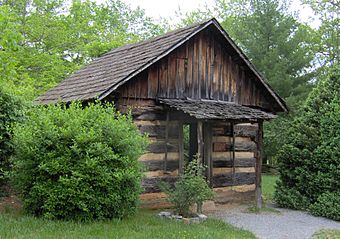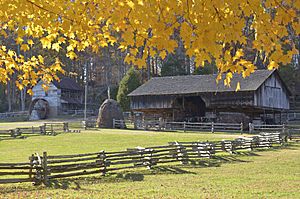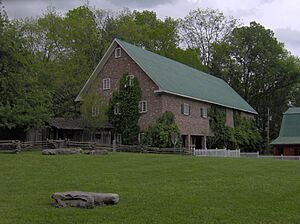Museum of Appalachia facts for kids
The Museum of Appalachia is a special place in Norris, Tennessee, about 20 miles north of Knoxville. It's like a time machine that shows you what life was like for pioneers and people in the early 1900s in the Southern Appalachian mountains of the United States.
This museum is part of the famous Smithsonian Institution. It has over 30 old buildings that were saved from falling apart. These buildings were moved to 63 acres of beautiful fields. The museum also keeps thousands of real old items, has one of the biggest collections of folk art in the country, and hosts shows with traditional Appalachian music. You can also see local artists and craftspeople showing how they make things.
A man named John Rice Irwin, who was a teacher and businessman from East Tennessee, started the museum in the 1960s. His main idea was to save not just the old buildings and items, but also their stories. He wanted to know who owned each item, how it was made, and how it was used. These stories and thousands of photos are kept safe in the museum's archives. The museum started with just one log cabin and has grown a lot. It now includes buildings like the Arnwine Cabin, which is on the National Register of Historic Places. There's also a special barn called a cantilever barn, and a cabin where author Mark Twain's parents and older brothers and sisters once lived. You can see items that belonged to famous Appalachian people and thousands of tools that show what daily life was like. The museum grounds look like a real pioneer farm, with gardens growing typical crops and animals like goats, chickens, turkeys, and peacocks walking around freely. John Rice Irwin once said, "What better way is there to know a people than to study the everyday things they made, used, mended, and cherished... And cared for with loving hands."
Contents
How the Museum Started
Museum founder John Rice Irwin was born in 1930 in Knox County, Tennessee. His family had lived in the region for a long time. His family later moved to Union County, but they had to move again when the Tennessee Valley Authority bought their land to build Norris Lake. They moved one more time in the early 1940s when their land was needed for the Manhattan Project.
John Rice Irwin always loved listening to older people in his community. He learned a lot about old tools and farm life from spending time on his grandparents' farm. He went to college at Lincoln Memorial University and the University of Tennessee. For several years, he worked as a businessman and a teacher, even leading the public schools in Anderson County.
In 1962, John Rice Irwin went to an auction at an old farm. He noticed that many people buying the items were taking them away from their history. He believed the items were most valuable because of their stories. So, he bought several things, including a box for shoeing horses that had been found in the Clinch River after a big flood in 1916.
Soon after, he got his first log building, called the General Bunch House. He moved it from a faraway part of the county. On weekends, Irwin looked for old items in remote communities around the region. He displayed these items in his yard and garage. In 1969, he officially opened the Museum of Appalachia and started charging a small fee to get in.
In 1977, one of the museum's cabins, the Patterson cabin, was used in a TV show called Young Dan'l Boone. It's now called the "Dan'l Boone Cabin," even though it has no real connection to the famous explorer Daniel Boone. In the mid-1980s, articles about the museum appeared in Parade and Reader's Digest magazines. John Rice Irwin also appeared on the Today Show. These things helped many more people learn about the museum and visit.
In the 1980s, the famous author Alex Haley visited the museum. He loved it so much that he decided to move to East Tennessee and bought a farm right across the street. Haley was inspired by the museum's Steve Parkey exhibit, which was about an African-American blacksmith. He planned to write a book about him. Alex Haley brought many famous people to the museum, including Oprah Winfrey, Jane Fonda, Brooke Shields, Lou Gossett Jr., and Quincy Jones.
Several episodes of WBIR-TV's show The Heartland Series were filmed at the museum. The very last episode of the series was filmed there on August 8, 2009. About 10,000 people came to watch, making it one of the biggest crowds the museum has ever seen.
What You Can See at the Museum
Outdoor Buildings and Log Cabins
Besides cabins and barns, the museum shows you all kinds of buildings you would find on a typical pioneer farm in Appalachia. These include smokehouses, corn cribs, animal pens, mills, an underground dairy, and a loom house. There are also blacksmith shops, a working sawmill, a country schoolhouse, a log church, a broom and rope shop, and a leather shop. All these buildings are filled with items from that time and are sometimes used for demonstrations.
The Display Barn
The museum's two-story Display Barn holds one of the biggest collections of pioneer items in the country. Along with thousands of old tools, the barn has a general store set up just like it would have been long ago. There's also a rural post office from Arthur, Tennessee. Some of the tools on display include an axe that might have been used at colonial Fort Loudoun. You can also see the shoeing box found in the Clinch River after the big flood. The collection includes photos and short descriptions that tell you who owned each item and how it was used.
The People's Building
Events and Celebrations
For 38 years, the museum hosted a big event called "Tennessee Fall Homecoming." This was one of the largest and most real music and folk festivals in the country. Many famous musicians performed all day on four outdoor stages. There were also evening shows with headlining artists. Some of the artists who played at Homecoming include Bill Monroe, Earl Scruggs, Marty Stuart, Old Crow Medicine Show, Lee Ann Womack, Jerry Douglas, The SteelDrivers, Ralph Stanley, John Hartford, Doc Watson, and Rhonda Vincent.
Special Buildings to See
Arnwine Cabin
Quick facts for kids |
|
|
Arnwine Cabin
|
|
 |
|
| Location | TN 61 |
|---|---|
| Nearest city | Norris, Tennessee |
| Built | 1800s |
| NRHP reference No. | 76001760 |
| Added to NRHP | 1976 |
The Arnwine Cabin was built between 1795 and 1820 using logs from poplar trees. The first known person to live there was John Wesley Arnwine. The cabin was originally located near the Clinch River in Grainger County. In the early 1930s, the Tennessee Valley Authority bought the land for Norris Lake, and the cabin was moved a short distance. Two of Arnwine's daughters, Polly Anne and Eliza Jane, lived in the cabin their whole lives. After Eliza Jane passed away in 1936, the cabin was used for storage and started to fall apart. John Rice Irwin bought the cabin in 1964 and moved it to the museum.
Irwin decided the roof couldn't be saved. So, he and two helpers split 5,400 shingles from one red oak tree to build the new roof. The cabin's floor was also missing. Irwin found an old wooden floor at a smokehouse near Sneedville and moved it to the Arnwine Cabin. The stone part of the chimney came from an old house near the museum, and a section made of sticks and mud was added. Over several years, the cabin was filled with real furniture, tools, and kitchen items from the pioneer time.
Mark Twain Family Cabin
The "Mark Twain family cabin" is thought to have belonged to Twain's father, John Clemens. He lived there with Twain's mother, Jane Lampton Clemens. It might even be where the author's older brothers and sisters, like Orion Clemens, were born. The cabin was originally in a community called Possum Trot in Fentress County, Tennessee. John Clemens worked there as a postmaster and court clerk. The cabin's chimney was added around 1905. The Museum of Appalachia bought and moved the cabin to the museum in 1995.
List of Historical Buildings
| Structure | Image | Built | Original location |
Builder/principal owner |
|---|---|---|---|---|
| Tom Cassidy house |  |
Union County, Tennessee | Tom Cassidy | |
| Gwen Sharp Playhouse |  |
1929 | Loyston, Tennessee | Sharp family neighbor |
| Jail cells |  |
1874 | Madisonville, Tennessee | |
| Leather and saddle shop |  |
Near Rogersville, Tennessee | Hobart Hagood (d. 1961) | |
| Mark Twain family cabin |  |
1830s | Near Pall Mall, Tennessee | John Clemens (1798–1847) |
| Wilson Barn |  |
Union County, Tennessee | ||
| Blacksmith and wheelwright shop | Near Andersonville, Tennessee | |||
| Bunch smokehouse |  |
c. 1830 | Grainger County, Tennessee | |
| General Bunch House |  |
1898 | Anderson County, Tennessee | Pryor Bunch (1852–1931) |
| Arnwine Cabin |  |
c. 1795-1820 | Grainger County, Tennessee | John Wesley Arnwine |
| Old Sharp corn mill | Union County, Tennessee | Sharp family | ||
| McClung Cabin |  |
1790s | Knoxville, Tennessee | McClung family |
| Broom and rope shop |  |
Clinchport, Virginia | Mary Carter | |
| Cox corn crib |  |
Near Norris, Tennessee | Bunk Cox | |
| Longworth corncrib | Claiborne County, Tennessee | Longworth family | ||
| Dan'l Boone Cabin |  |
Early 19th century | Anderson County, Tennessee | Patterson family |
| Sheep pen | Near Clinton, Tennessee | Wilshire family | ||
| Big Tater Valley School |  |
early 19th century | Grainger County, Tennessee | Crockett Skeen |
| Irwin's Chapel Church |  |
c. 1840 | Madison County, North Carolina | Thomas Tweed |
| Peters Homestead house |  |
c. 1790-1838 | Near Luttrell, Tennessee | John Peters, Nathaniel Peters |
| Homestead loom house |  |
Near Maynardville, Tennessee | Bishop Hatmaker | |
| Homestead smokehouse and granary |  |
Powell Valley, Tennessee | Childress family | |
| Parkey blacksmith shop |  |
Hancock County, Tennessee | Steve Parkey | |
| Whiskey still |  |
Marvin "Popcorn" Sutton (set up) | ||
| Joe Diehl Sawmill |  |
Early 20th century | Knox County, Tennessee | |
| Cantilever barn |  |
Seymour, Tennessee | Unknown | |
| Hacker Martin Gristmill |  |
1790s | Near Gray, Tennessee | Coonrod Dove |
More to Explore
- Great Smoky Mountains Heritage Center
- List of music museums
- Open-air museum





